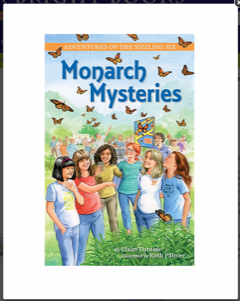YA Eco Mysteries, Memoirs, Novels & Travel
The Last Whaling Station
The Last Whaling Station Point San Pueblo California
A Visit to the Setting of the Story
Reality met the setting I imagined on my trip to the Last Whaling in the US, San Pueblo Point, East Bay California. This is an excerpt from The Gray Whale's Lament after my trip.
Chapter 8. The Last Whaling Station
They drove on the freeway through heavy traffic and then across the long, roller coaster-like San Rafael Bridge. Nearing their destination at Point Molate Naval Base, they passed an old air raid shelter with castle-like brown brick walls covered in vines.
Searching the internet Sarah exclaimed, “Mom, this is so interesting . . . did you know that Native Americans fished right here for centuries, and that in the late 1800s it was a Chinese shrimp camp?”
“I knew about the shrimp camp and of course there were native Americans living here long before us. Their ancestors still live around this place. If we dig in the earth we might find shards of their pottery, the shells of the mussels, and the bones fish they ate.”
“Ooh, that gives me goose bumps.” Sarah shivered.
At Point San Pablo, the road had been blocked by security guards, so they turned right at a fork, winding around a hill. Noticing that her mother was clutching the steering wheel so tightly her knuckles were white, Sarah asked, “Mom, what’s wrong?”
“This is where your Grandmother Rose took the picture of the whaling station,” she replied.
“Stop, Mom! I want to take a picture at this spot,” Sarah said.
Bumping off the road, they parked on a grassy shoulder. Then the two hiked to the top of the hill.
“Is that where the whales were killed?” Sarah asked, pointing across the bay.
“Yes.” Her mother sighed. Standing shoulder to shoulder they listened to the wind rustling through the golden, dry grass at their feet. The wind picked up, flattening the grass, and howling across the waves.
Sarah shivered. “It sounds like the ghosts of long ago still haunt this place.”
Her mother squeezed her hand. “It’s okay to remember the past,” she said, dabbing away tears. “Even upsetting memories can motivate you to do something worthwhile.”
Sarah began snapping pictures. “Still, it’s peaceful here. It’s hard to believe this bay was home to the last active whaling station where whales were slaughtered in the US.”
***
Ramp for Dragging whales into the Whaling Station
Finally, they pulled into the parking lot, hidden around a bend at the end of the road, at Point San Pablo Yacht Harbor.
With the Chummy at her heels and binoculars in hand, Sarah tumbled out of the car. Pulling out her mobile phone, she snapped photos of houseboats, and floating homes that lined the bay.
Houseboats San Pueblo Point, East Bay California
She couldn’t resist taking a picture of the funky, oversized sculpture of an alligator with jaws wide open.
Oversized Sculpture of an Alligator, San Pueblo Hatch Club
Even the historic old shacks and rusting machinery made interesting pictures. As they walked by, the harbor master waved and called out, “Don’t forget to visit the farm with goats and order something to eat at the restaurant.”
They came to the pebbly beach where a sign that read: OK for launching kayaks, canoes, etc. Chummy trotted along the beach stopping to sniff at invisible scents. Her mother rubbed her forehead, “It’s changed since I was here years ago.”
“I can’t see the old whaling station,” Sarah said, looking through her binoculars.
“We need to drive to the North side of the point where we can see across the bay to the remains of the whaling station.”
They got back in the car and within minutes they arrived at the point. Chummy leapt out of the car and began to bark, “Be quiet!” Sarah command her dog to stop him from barking at the elephant seals rumbling contentedly while sunning themselves on the rocks. She could make see the blackened wooden posts, which had supported the pier and the gangplank up to the factory. Her mother had been right, there was nothing to tell of the horror that had happened here. No witness to how ruthlessly the whales had been slaughtered.
Chocking back curse words she hissed, “Nasty, stupid—.”
Just then Chummy began yipping. She turned and saw her dog digging furiously at something half-buried in the sand.
“Chummy, come here,” Sarah called. The dog raced toward her, then turned back to continue digging, sending sand flying.
“What have you got there, boy?” Sarah strode over to Chummy. It appeared to be blue plastic bottle cap sticking out of the sand. Getting down on her knees, she rocked the bottle loose. She brushed off the sand she held it up to the light. It was an ordinary plastic water bottle with a roll of paper inside. There was also a plastic bag with something tiny curled inside. Peering more closely she could make out what appeared to be tiny black eye in a white face and a curled body. The image of the fetus in her dream flared in her mind. She dropped the bottle as if it were a scorpion readying to sting her.
“Calm down. It’s just a bottle with a plastic bag and some junk inside it. Nothing to be afraid of.”
“What is it?” Sarah asked, her breath catching in her throat.
“I can’t tell for sure,” her mother said. “Maybe it’s a message or treasure from a castaway pirate stranded on a deserted tropical island,” her mother joked.
“Right, and we should row over to save him right now,” Sarah said, brushing off the sand clinging to Chummy.
ECO Fiction Writer's Blog Episode Two
Would you like to go on a journey with me to faraway places—one that takes unexpected twists and turns? You don’t need to pack a thing or purchase a ticket. I will be your guide as we travel through time and space, meet fascinating people, and gain a different perspective as I research and write my newest eco adventure, Whale’s Lament (working title). All you need to bring along is your curiosity and imagination and, of course, internet access. To receive my Newsletter with links to new episodes: subscribe by email: cldatnow@me.com. To begin reading “A Writers Journey: A Whales Lament,” visit my blog on: mediamint.net.
Send Your Questions and Ideas to cldatnow@me.com—they are most welcome
Our Journey begins in Nahoon, Alaska as Alysie Muckpa searches for the gray whale, she has named Natsilane:
Chapter One. Episode 2
The breakers swirled around the inky shadow in broad circles, then drained away as if sliding sideways from a submerged rock. As the shadow wallowed closer, Alysie could make out a huge, streamlined body and narrow head. Leaping off the boulder, she raced closer to the shoreline.
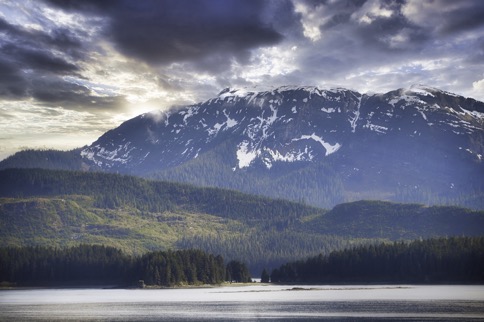
Storm Clouds Icy Point Straight Alaska (Boris Datnow)
There was something about its sluggish movement that made goosebumps prickle her arms. As if she were in a nightmare, Alysie could not turn away. “Calm down, get a grip!” she chided herself.
The body kept on rolling closer. The pull of the receding waves sucked it back pulled it forward. With each incoming breaker she could see the shape more clearly: the hump on its back, the line of knobs along its spine, its paddle-shaped flippers and broad tail. Push-pull, forward-backward. The ocean rocked the mighty whale in its arms, sending it closer and closer to shore where it would be stranded, trapped, unable to move its great body back into the water.
Alysie rushed into the churning ocean. Above the drumming of the waves slamming on shore and the thunder rumbling around the cove, she screamed “Natsilane stay away! Stay Away!” Pursing her lips tight over the tip of her conch shell she blew with all her might. Nothing happened. She blew again, AAAARRRRRUUUUUUUUUUUUUU! The wind tore the sound around the bay. But the incoming tide had Natsilane in its grip. As if she could shove a forty ton whale back into the ocean, she stood there with her hands outstretched. Still the whale kept on coming.
Dragging her eyes away, Alysie squeezed them shut and sent up a prayer to the Tlinglit warrior, Blackfish, who rode on the back of a whale.
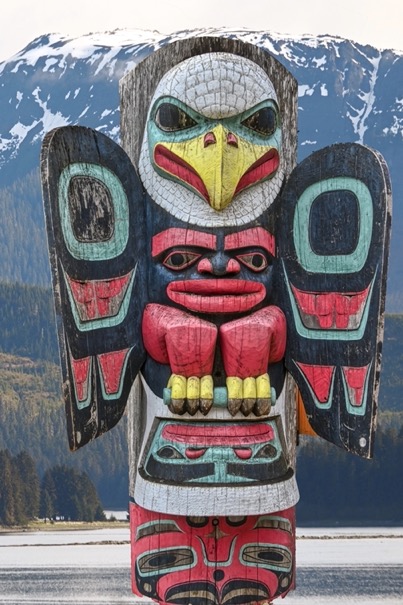
Tlingit Totem Pole Hoonah Alsaka (Boris Datnow)
A sour odor, like a shred of rotting fish, slammed into her. With a sick feeling in the pit of her stomach, her eyes flew open . . .
To read the next episode: Subscribe to cldatnow.
Send Your Questions and Ideas to cldatnow@me.com—they are most welcome
To inspire you along the way here are ideas, travel destinations, and books to enjoy.
Travel: Boris and I visited Alaska in 2019. The villages and towns we explored inspired the background to this story. We are planning to visit Baja California in February 2022 where gray whales migrate to the lagoons to mate and have their calves.
Documentary: Life Among Whales, streaming on PBS, narrated by Robert Payne.
Books: Fathoms: The World in the Whale by Rebecca Giggs
Ice Whale by Jean Craighead
Song for a Whale by Lynn Kelley
Articles: The Last Whaling Station in America http://www.lakata.org/arch/whaling.html
National Oceanic and Atmospheric Administration (and an exceedingly long list of other resources)
https://hakaimagazine.com/features/are-we-on-the-verge-of-chatting-with-whales/
Subscribe to my newsletter and blog at mediamint.net to read the next episodes.
Eco Fiction Writer's Blog Episode One
Claire Datnow's Writing Adventures
Would you like to go on a journey with me to faraway places—one that takes unexpected twists and turns? You don’t need to pack a thing or purchase a ticket. I will be your guide as we travel through time and space, meet fascinating people, and gaining a different perspective as I research and write my newest Eco adventure, The Whales Lament. All you need to bring along is your curiosity and imagination— and, of course, internet access. To begin this journey subscribe by email to: cldatnow@me.com
Note: The Whales Lament is the second book in a proposed cli-fi trilogy. Red Flag Warning: An Eco Adventure, first book in the trilogy, can be purchased from Amazon or downloaded on Kindle.
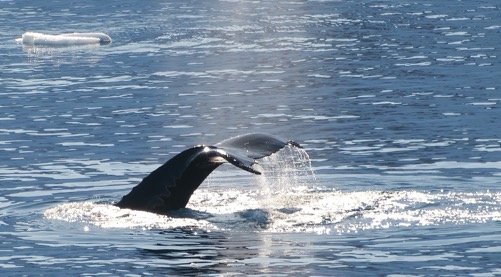
The Whale's Lament (Boris Datnow)
Our Journey Begins: Nahoon, Alaska as Alysie Muckpa searches for the gray whale, Natsilane:
Part One.
It is late spring on Chichagof Island, Alaska and the air and the water are warming. The bears have wakened from their long winter sleep. And all eyes gazing out to sea for the most graceful giants the gray whale. It is here they begin and end the longest migration of any mammal, 12,000 miles from the summer feeding grounds in the icy waters of the Arctic to their breeding grounds in the warm lagoons of Baja, Mexico—and back again with the changing seasons. This migration can take two to three months. Gray whales normally travel alone or in small groups. They surface only for a quick spout of air and breath before disappearing into the ocean. Instead of teeth, gray whales have baleen which is like a thick comb with long hairs. Diving down to the muddy bottom, they scoop up sediment form the ocean floor filtering out mud and trapping plankton and krill to eat. In the seventeen and eighteen hundreds whalers in search of oil hunted gray whales to near extinction. In 1946 and international treaty was singed to provide oversight and management of whale hunting. But it was under the protection of the Endangered Species Act in 1974 and National Oceanic and Atmospheric Administration’s (NOAH) careful management that the eastern pacific gray whale has recovered to a sustainable population. Today, nearly 24,000 gray whales continue their annual migration along the coast of North America, giving humans a glimpse of these majestic creatures that live in the deep. However, many factors still threaten gray whales including: vessel strikes, disruption of their migration routes, and entanglement in fishing gear. The whales that lived in the Western Pacific are no longer seen along the Asian shores. Baleen whales are acoustic animals and can communicate across entire oceans using vocalizations. Every species of whale speaks a unique "language" and scientists are still trying to learn what information whales communicate to one another.
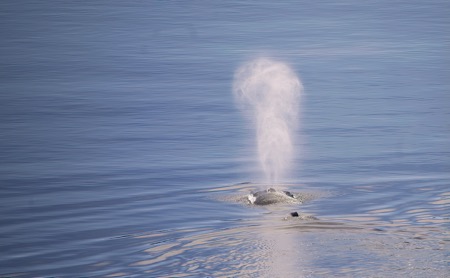
Spouting Whale, Antarctica (Boris Datnow)
Chapter One. Nahoon Alaska on Chicagof Island in the early spring.
Shading her eyes from the glow of the rising sun, Alysie Muckpa stood alone on the rugged cliffs gazing out to sea like a sailor longing for the sight of land. The wind tore at her hair, unraveled her braids and whistled in her ears. The night before, she had dreamed she was riding high on her whale’s back, with her black hair flowing behind her . . . steering him through the towering waves. With the dream still floating in her head, she had crept out of the house, carrying a backpack with snacks, water, a rain poncho, a flashlight, and her special whorled shell prepared to stay on watch even even if a storm broke.
Alysie ignored the gulls screaming by on near-gale gusts, and the plovers bobbing along the shore. The peregrine falcon winging swiftly across cliffs; the waves sloshing into the tide pools alive with hermit crabs, sea stars, sea cucumbers and sea urchins. On any other day, she would have lingered to marvel at the rainbow of creatures in the pool. On that day she kept her eyes focused on the ocean, searching for the misty spray of a whale or its dark shadow lurking beneath the water.
Something in the curve of the waves caught Alysie’s attention. A thrill tingled down her spine. Raising the binoculars to her eyes, she gasped in surprise. SUBSCRIBE to read more about what happens next.
To inspire you along the way here are ideas, travel destinations, and books to enjoy.
Send Your Questions and Ideas to cldatnow@me.com—they are most welcome
Travel: Boris and I visited Alaska in 2019. The villages and towns we explored inspired the background to this story. We are planning to visit Baja California in February 2022 where gray whales migrate to the lagoons to mate and have their calves.
Documentary: Life Among Whales, streaming on PBS, narrated by Robert Payne.
Books: Fathoms: The World in the Whale by Rebecca Giggs
Ice Whale by Jean Craighead
Song for a Whale by Lynn Kelley
Articles: The Last Whaling Station in America http://www.lakata.org/arch/whaling.html
National Oceanic and Atmospheric Administration (and an exceedingly long list of other resources)
Eco Fiction Writer's Blog Episode One
Claire Datnow's Writing Adventures
Would you like to go on a journey with me to faraway places—one that takes unexpected twists and turns? You don’t need to pack a thing or purchase a ticket. I will be your guide as we travel through time and space, meet fascinating people, and gaining a different perspective as I research and write my newest Eco adventure, The Whales Lament. All you need to bring along is your curiosity and imagination— and, of course, internet access. To begin this journey subscribe by email to: cldatnow@me.com
Note: The Whales Lament is the second book in a proposed cli-fi trilogy. Red Flag Warning: An Eco Adventure, first book in the trilogy, can be purchased from Amazon or downloaded on Kindle.

The Whale's Lament (Boris Datnow)
Our Journey Begins: Nahoon, Alaska as Alysie Muckpa searches for the gray whale, Natsilane:
Part One.
It is late spring on Chichagof Island, Alaska and the air and the water are warming. The bears have wakened from their long winter sleep. And all eyes gazing out to sea for the most graceful giants the gray whale. It is here they begin and end the longest migration of any mammal, 12,000 miles from the summer feeding grounds in the icy waters of the Arctic to their breeding grounds in the warm lagoons of Baja, Mexico—and back again with the changing seasons. This migration can take two to three months. Gray whales normally travel alone or in small groups. They surface only for a quick spout of air and breath before disappearing into the ocean. Instead of teeth, gray whales have baleen which is like a thick comb with long hairs. Diving down to the muddy bottom, they scoop up sediment form the ocean floor filtering out mud and trapping plankton and krill to eat. In the seventeen and eighteen hundreds whalers in search of oil hunted gray whales to near extinction. In 1946 and international treaty was singed to provide oversight and management of whale hunting. But it was under the protection of the Endangered Species Act in 1974 and National Oceanic and Atmospheric Administration’s (NOAH) careful management that the eastern pacific gray whale has recovered to a sustainable population. Today, nearly 24,000 gray whales continue their annual migration along the coast of North America, giving humans a glimpse of these majestic creatures that live in the deep. However, many factors still threaten gray whales including: vessel strikes, disruption of their migration routes, and entanglement in fishing gear. The whales that lived in the Western Pacific are no longer seen along the Asian shores. Baleen whales are acoustic animals and can communicate across entire oceans using vocalizations. Every species of whale speaks a unique "language" and scientists are still trying to learn what information whales communicate to one another.

Spouting Whale, Antarctica (Boris Datnow)
Chapter One. Nahoon Alaska on Chicagof Island in the early spring.
Shading her eyes from the glow of the rising sun, Alysie Muckpa stood alone on the rugged cliffs gazing out to sea like a sailor longing for the sight of land. The wind tore at her hair, unraveled her braids and whistled in her ears. The night before, she had dreamed she was riding high on her whale’s back, with her black hair flowing behind her . . . steering him through the towering waves. With the dream still floating in her head, she had crept out of the house, carrying a backpack with snacks, water, a rain poncho, a flashlight, and her special whorled shell prepared to stay on watch even even if a storm broke.
Alysie ignored the gulls screaming by on near-gale gusts, and the plovers bobbing along the shore. The peregrine falcon winging swiftly across cliffs; the waves sloshing into the tide pools alive with hermit crabs, sea stars, sea cucumbers and sea urchins. On any other day, she would have lingered to marvel at the rainbow of creatures in the pool. On that day she kept her eyes focused on the ocean, searching for the misty spray of a whale or its dark shadow lurking beneath the water.
Something in the curve of the waves caught Alysie’s attention. A thrill tingled down her spine. Raising the binoculars to her eyes, she gasped in surprise. SUBSCRIBE to read more about what happens next.
To inspire you along the way here are ideas, travel destinations, and books to enjoy.
Send Your Questions and Ideas to cldatnow@me.com—they are most welcome
Travel: Boris and I visited Alaska in 2019. The villages and towns we explored inspired the background to this story. We are planning to visit Baja California in February 2022 where gray whales migrate to the lagoons to mate and have their calves.
Documentary: Life Among Whales, streaming on PBS, narrated by Robert Payne.
Books: Fathoms: The World in the Whale by Rebecca Giggs
Ice Whale by Jean Craighead
Song for a Whale by Lynn Kelley
Articles: The Last Whaling Station in America http://www.lakata.org/arch/whaling.html
National Oceanic and Atmospheric Administration (and an exceedingly long list of other resources)
